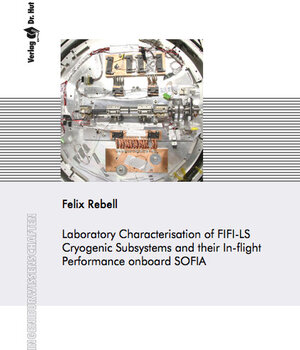
×
![Buchcover ISBN 9783843947947]()
Laboratory Characterisation of FIFI-LS Cryogenic Subsystems and their In-flight Performance onboard SOFIA
von Felix RebellThe Stratospheric Observatory for Infrared Astronomy (SOFIA) is the most recent airborne telescope allowing astronomers to observe the night sky in infrared wavelengths. FIFI-LS, the Field Imaging Far Infrared Line Spectrometer is one of several scientific instruments that can be mounted to the SOFIA telescope. This thesis focuses on two internal FIFI-LS subsystems and their characterization in the lab and in-flight.
The first part concentrates on the grating mechanism. The observed wavelength is set by rotating a diffraction grating to a defined angular position. The rotating mechanism and its heart, a planetary roller screw, has to operate under vacuum, from 300K to 6K and withstand the in-flight vibrations. Malfunction or even failure of the mechanism can cripple the instrument or even end an expensive SOFIA flight series. In this thesis, the positional stability was characterized and it provides the first reliable lifetime estimates of the drive in a cryogenic environment based on experimental data.
The second part of this thesis is dedicated to the characterization of the internal calibration source. The FIFI-LS detectors are custom made and every pixel has an individual spectral responsivity. An internal calibration source was designed to provide the possibility to check the response of the detectors to a known, uniform signal during flight or in the lab. In the frame of this work the performance of the calibration source with respect to signal strength, stability and spectral behavior was determined.
The first part concentrates on the grating mechanism. The observed wavelength is set by rotating a diffraction grating to a defined angular position. The rotating mechanism and its heart, a planetary roller screw, has to operate under vacuum, from 300K to 6K and withstand the in-flight vibrations. Malfunction or even failure of the mechanism can cripple the instrument or even end an expensive SOFIA flight series. In this thesis, the positional stability was characterized and it provides the first reliable lifetime estimates of the drive in a cryogenic environment based on experimental data.
The second part of this thesis is dedicated to the characterization of the internal calibration source. The FIFI-LS detectors are custom made and every pixel has an individual spectral responsivity. An internal calibration source was designed to provide the possibility to check the response of the detectors to a known, uniform signal during flight or in the lab. In the frame of this work the performance of the calibration source with respect to signal strength, stability and spectral behavior was determined.


